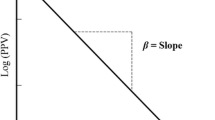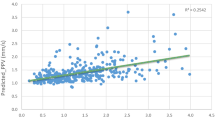Abstract
The prediction of ground vibration is of great importance in the alleviation of the detrimental effects of blasting. Therefore, a vibration control study to minimize the harm of ground vibration and its influence on nearby structures can play an important role in the mining industry. In this paper, a dimensional analysis (DA) technique has been performed on various blast design parameters to propose a new formula for the prediction of the peak particle velocity (PPV). After obtaining the DA formula, 105 data sets were used to determine the unknown coefficients of the DA equation, as well as site constants of different conventional predictor equations. Then, 12 new blast data sets were used to compare the capability of the DA formula with conventional predictor equations. The results were compared based on the coefficient of determination and mean absolute error between measured and predicted values of the PPV.










Similar content being viewed by others
References
Alhama F, Madrid CN (2007) Discriminated dimensional analysis versus classical dimensional analysis and applications to heat transfer and fluid dynamics. Chin J Chem Eng 15:626–631
Álvarez-Vigil AE, González-Nicieza C, López Gayarre F, Álvarez-Fernández MI (2012) Predicting blasting propagation velocity and vibration frequency using artificial neural networks. Int J Rock Mech Min Sci 55:108–116
Ambraseys NN, Hendron AJ (1968) Dynamic behaviour of rock masses. In: Stagg KG, Zienkiewicz OC (eds) Rock mechanics in engineering practices. Wiley, London, pp 203–207
Bakhshandeh AH, Mozdianfard MR, Siamaki A (2010) Predicting of blasting vibrations in Sarcheshmeh copper mine by neural network. Saf Sci 48:319–325
Bakhshandeh AH, Siamaki A, Soltani S (2012) Design of blasting pattern in proportion to the peak particle velocity (PPV): artificial neural networks approach. Saf Sci 50:1913–1916
Bellamine FH, Elkamel A (2006) Numerical characterization of distributed dynamic systems using tools of intelligent computing and generalized dimensional analysis. Appl Math Comp 182:1021–1039
Bluman GW, Anco SC (2002) Symmetry and integration methods for differential equations. Springer, New York, pp 1–15
Bureau of Indian Standards (BIS) (1973) Criteria for safety and design of structures subjected to underground blast. ISI Bull; IS-6922
Dehghani H, Ataee-Pour M (2011) Development of a model to predict peak particle velocity in a blasting operation. Int J Rock Mech Min Sci 48:51–58
Deng J, Luo Z, Wu X, Hu Y (2010) Explosive limits of mixed gases containing CH4, CO and C2H4 in the goaf area. Min Sci Tech 20:557–562
Dowding CH (1992) Suggested method for blast vibration monitoring. Int J Rock Mech Min Sci Geomech Abstr 29:143–156
Duvall WI, Fogelson DE (1962) Review of criteria for estimating damage to residences from blasting vibrations. USBM-I, 5968
Farinha AR, Mendes R, Baranda J, Calinas R, Vieira MT (2009) Behavior of explosive compacted/consolidated of nanometric copper powders. J Alloys Compd 483:235–238
Gibbings JC (2011) Dimensional analysis. Springer, London, p 57
Hagan TN (1973) Rock breakage by explosives. In: Proceedings of the national symposium on rock fragmentation, Adelaide, Australia, February 1973, pp 1–17
Hino K (1959) Theory and practice of blasting. Nippon Kayaku Co. Ltd., Japan
Hudaverdi T (2012) Application of multivariate analysis for prediction of blast-induced ground vibrations. Soil Dyn Earthq Eng 43:300–308
Khandelwal M (2010) Evaluation and prediction of blast induced ground vibration using support vector machine. Int J Rock Mech Min Sci 47(3):509–516
Khandelwal M (2011) Blast-induced ground vibration prediction using support vector machine. Eng Comput 27:193–200
Khandelwal M, Singh TN (2006) Prediction of blast induced ground vibrations and frequency in opencast mine: a neural network approach. J Sound Vib 289(4–5):711–725
Khandelwal M, Singh TN (2007) Evaluation of blast-induced ground vibration predictors. Soil Dyn Earthq Eng 27(2):116–125
Khandelwal M, Singh TN (2009) Prediction of blast-induced ground vibration using artificial neural network. Int J Rock Mech Min Sci 46(7):1214–1222
Khandelwal M, Kumar DL, Yellishetty M (2011) Application of soft computing to predict blast-induced ground vibration. Eng Comput 27:117–125
Langefors U, Kihlström B (1963) The modern technique of rock blasting. Wiley, New York
Liang Q, An Y, Zhao L, Li D, Yan L (2011) Comparative study on calculation methods of blasting vibration velocity. Rock Mech Rock Eng 44:93–101
Mohamadnejad M, Gholami R, Ataei M (2012) Comparison of intelligence science techniques and empirical methods for prediction of blasting vibrations. Tunn Undergr Space Technol 28:238–244
Mohamed MT (2009) Artificial neural network for prediction and control of blasting vibrations in Assiut (Egypt) limestone quarry. Int J Rock Mech Min Sci 46(2):426–431
Monjezi M, Hasanipanah M, Khandelwal M (2013) Evaluation and prediction of blast-induced ground vibration at Shur River Dam, Iran, by artificial neural network. Neural Comput Appl 22:1637–1643. doi:10.1007/s00521-012-0856-y
Rustan A (1998) Rock blasting terms and symbols. A.A. Balkema, Rotterdam
Sambuelli L (2009) Theoretical derivation of a peak particle velocity–distance law for the prediction of vibrations from blasting. Rock Mech Rock Eng 42:547–556
Scheaffer R, Mulekar M, McClave J (2011) Probability and statistics for engineers, 5th edn. Brooks/Cole, Boston, p 88
Sharp JJ, Deb A, Deb MK (1992) Applications of matrix manipulation in dimensional analysis involving large numbers of variables. Mar Struct 5:333–348
Singh VK (2004) Northern Coalfields Ltd.: surging ahead with time. J Mines Met Fuels, p 51
Young DF, Munson BR, Okiishi TH, Huebsch WW (2010) A brief introduction to fluid mechanics, 5th edn. Wiley, New York, p 240
Author information
Authors and Affiliations
Corresponding author
Rights and permissions
About this article
Cite this article
Khandelwal, M., Saadat, M. A Dimensional Analysis Approach to Study Blast-Induced Ground Vibration. Rock Mech Rock Eng 48, 727–735 (2015). https://doi.org/10.1007/s00603-014-0604-y
Received:
Accepted:
Published:
Issue Date:
DOI: https://doi.org/10.1007/s00603-014-0604-y




